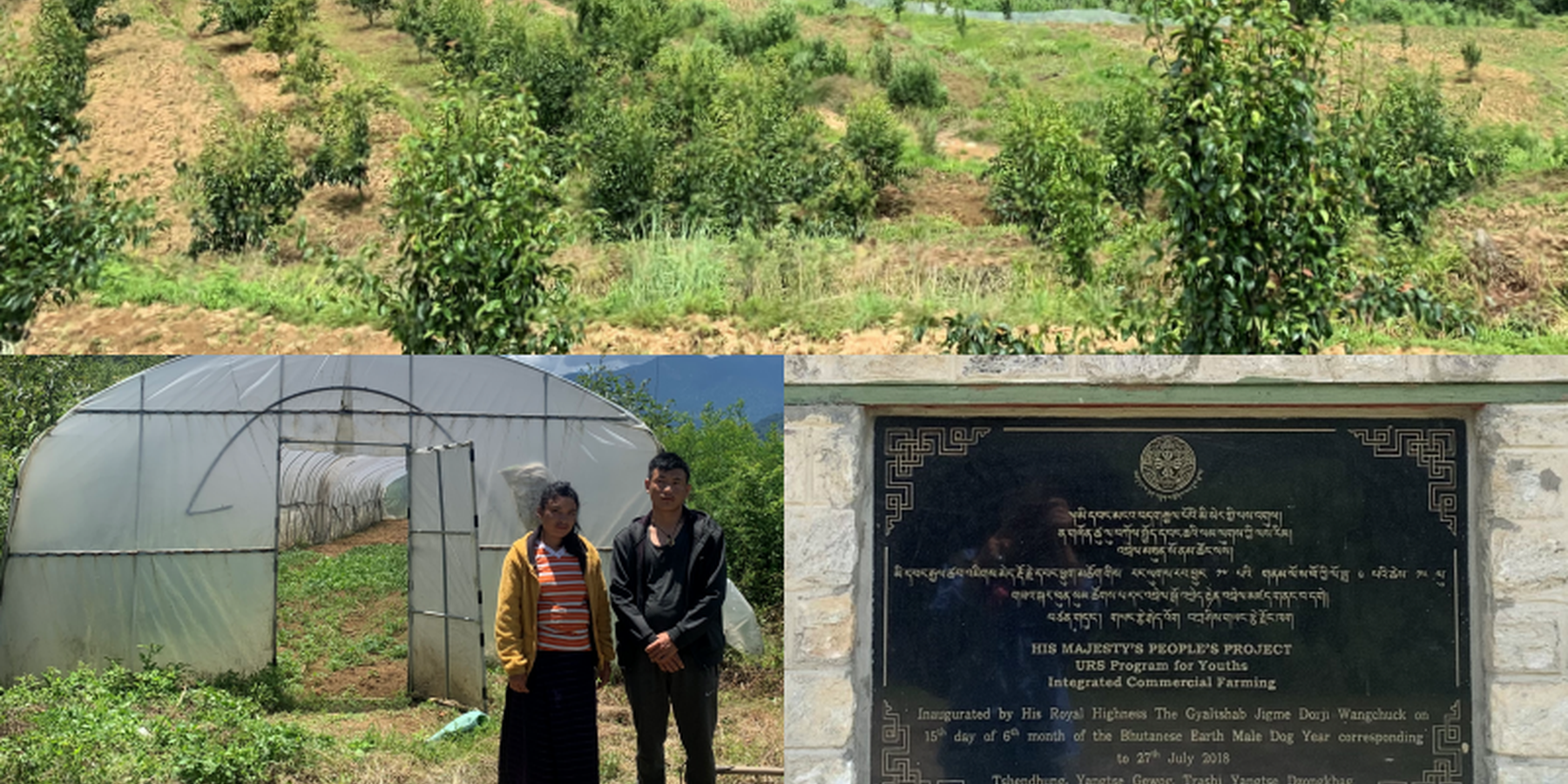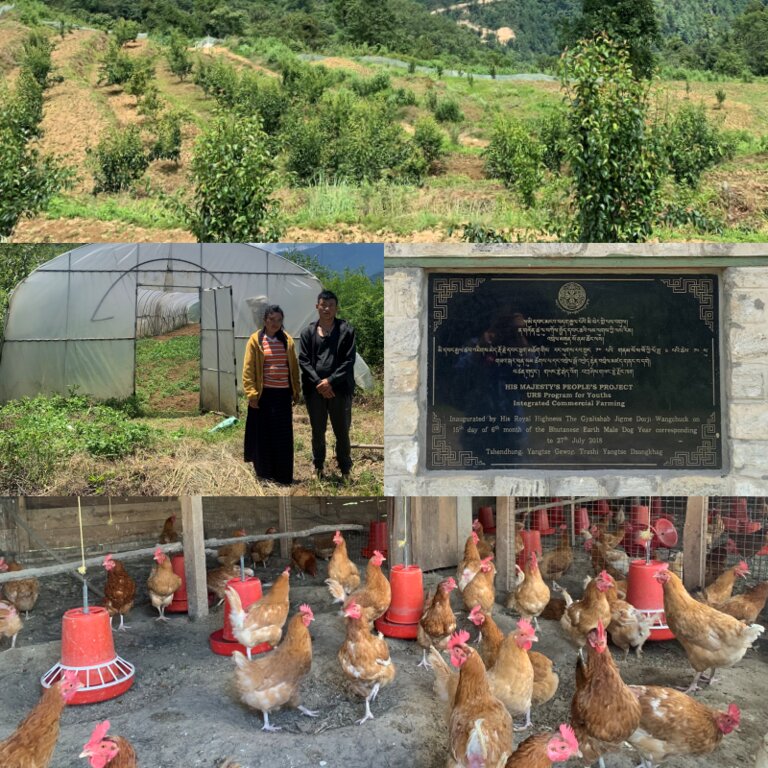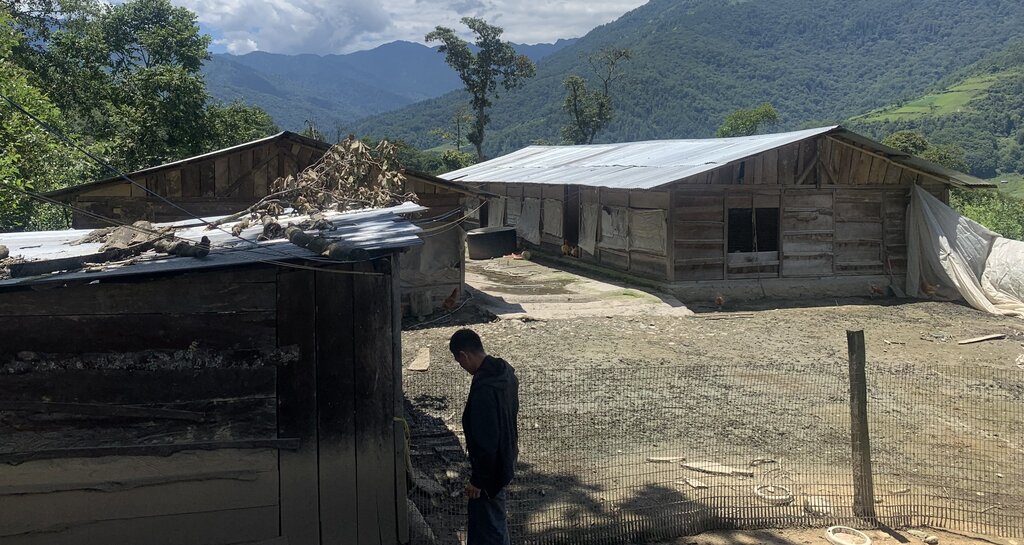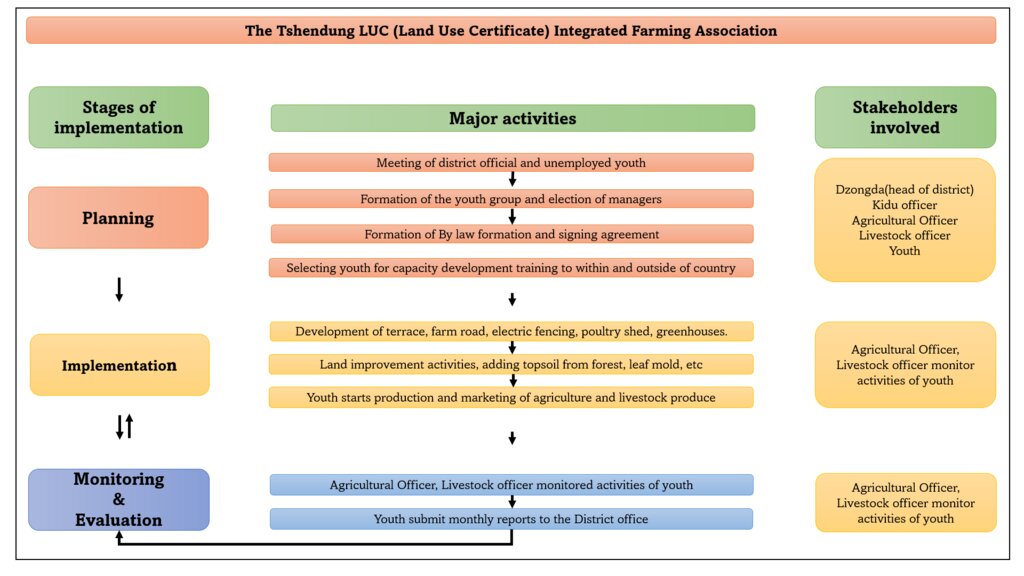Land Use Certificate to engage youth in Agriculture [بوتان]
- تاريخ الإنشاء:
- تحديث:
- جامع المعلومات: ONGPO LEPCHA
- المحرر: chenga Tshering
- المراجعون: William Critchley, Rima Mekdaschi Studer, Joana Eichenberger
Nazhoen Sanam Na Dreltog Baeni Dhoen Lu Sa Chha Koelched Lagkher (ན་གཞོན་སོ་ནམ་ནང་འབྲེལ་གཏོགས་འབད་ནིའི་དོན་ལུ་ས་ཆ་བཀོལ་སྤྱོད་ལག་ཁྱེར།)
approaches_6886 - بوتان
عرض الأقسام
توسيع الكل طي الكل1. معلومات عامة
1.2 تفاصيل الاتصال بالأشخاص الرئيسيين لمصدر المعلومات والمؤسسات المعنية بتقييم وتوثيق النهج
الشخص (الأشخاص) الرئيسي لمصدر المعلومات
مستخدم الأرض:
Tenzin Kuenzang
17582178
Tshendung, Lichen Chiwog, Yangtse gewog
بوتان
مستخدم الأرض:
Wangmo Sither
17459445
Tshendung, Lichen Chiwog, Yangtse gewog
بوتان
اسم المشروع الذي سهّل توثيق/تقييم النهج (إذا كان ذلك على صلة)
Strengthening national-level institutional and professional capacities of country Parties towards enhanced UNCCD monitoring and reporting – GEF 7 EA Umbrella II (GEF 7 UNCCD Enabling Activities_Umbrella II)اسم المؤسسة (المؤسسات) التي سهلت توثيق/تقييم النهج (إذا كان ذلك على صلة)
National Soil Services Centre, Department of Agriculture, Ministry of Agriculture & Livestock (NSSC) - بوتان1.3 الشروط المتعلقة باستخدام البيانات الموثقة من خلال WOCAT
متى تم تجميع البيانات (ميدانيا)؟:
19/07/2023
يوافق جامع المعلومات والشخص (لاشخاص) الرئيسي لمصدر المعلومات على الشروط المتعلقة باستخدام البيانات الموثقة من خلال WOCAT:
نعم
2. وصف نهج الإدارة المستدامة للأراضي
2.1 وصف موجز للنهج
The Land Use Certification (LUC) commenced in 2015 as the new allocation system for land and provided a new title of land tenure. Initially, LUC focused on allotting land to Government institutions and Gerab Dratshang (monastic bodies). However, LUC later focused on the unemployed youth who were interested in commercial farming.
2.2 وصف تفصيلي للنهج
وصف تفصيلي للنهج:
The Land Use Certification (LUC) commenced in 2015 as the new system for the allocation of land and a new title of land tenure. Initially, LUC focused on allotting land to Government institutions and Gerab Dratshang (monastic bodies). However, LUC later focused on the unemployed youth who were interested in commercial farming. This documentation is based on the LUC group ‘Tshendung LUC Integrated Farming Association'.
The main aims of the LUC approach are 1) to help sustainably manage and enhance productive use of land, 2) to encourage next-generation farming through farm mechanization and large-scale enterprising farming, and 3) to enhance the rural economy.
The approach started as an initiative towards the realization of the noble vision of strengthening sovereignty and security and enhancing social policy of equity and the national objective of self-reliance. Unemployed youth groups are expected to help sustainably manage and enhance the productive use of land - and the approach was to encourage next-generation farming through farm mechanization and large-scale production to promote enterprise-based farming and enhance the rural economy. Initially, it started with a meeting between district officials and unemployed youth. Later, bylaws were created, and agreements were signed. This was followed by sending youth for capacity development within and outside the country. They were trained on how to operate power tillers, use grass cutters and chain saws, and on the installation of electric fencing and greenhouses. In addition, they were trained in how to grow vegetables, fruit crops, and livestock production. In parallel infrastructure development activities were taking place in the current project sites.
The Tshendung LUC Integrated Farming Association enables land users to carry out agricultural activities more effectively. In addition, the association was able to transport and market their produce more efficiently than individual households. Other co-benefits reported are the improved community sense and enhanced social cohesion because the exchange of experiences and collaboration builds mutual trust. Working in a group eases hard physical work on the 9 acres (3.6 ha) of land.
The District Office initiated the group formation upon command from higher authority. They were also involved in planning, forming groups, bylaws, and monitoring the activities of the group. The District agricultural and livestock officers provided technical guidance on crop and livestock production. They also provided them with agricultural inputs. Lichen Primary School are consumers of the agricultural and livestock goods produced by the group. Land users are involved in planning the production and marketing of agricultural and animal products.
Initially, there were 11 youths in the group. They were provided with wide-ranging training and support including the preparation of land for growing crops and the construction of their residence. In addition to agricultural inputs like seeds, and saplings, the group was also provided farm machinery and farm tools for easy implementation of farm works. The group is happy with all the initiatives the government has done, however, one thing that discouraged the group from continuing with farming activities was the location of the site. They didn't like the location - which is in the middle of the forest around 15-20km away from the town. This makes transportation of agricultural inputs like seeds and feeds and marketing of agricultural and livestock products very difficult. The government initially supported the group with everything but later this support was withdrawn, which made it very difficult for the group to survive on their own.
2.3 صور عن النهج
2.5 البلد/المنطقة/المواقع التي تم تطبيق النهج فيها
البلد:
بوتان
المنطقة/الولاية/المحافظة:
Lichen, Trashi Yangtse: Bhutan
مزيد من التفاصيل حول الموقع:
Tshendung, Lichen chiwog (village), Yangtse gewog (sub district): Trashi Yangtse Dzongkhag (District)
Map
×2.6 تواريخ بدء وإنهاء تنفيذ النهج
أشر إلى سنة البدء:
2015
في حالة عدم معرفة السنة بالتحديد، يرجى الإشارة إلى التاريخ التقريبي لبدء النهج:
منذ أقل من 10 سنوات (مؤخرًا)
التعليقات:
The Land Use Certification (LUC) is an initiative commenced in 2015 as the new allotment system of land and a new title of land tenure.
2.7 نوع النهج
- مبادرة محلية حديثة/مبتكرة
2.8 الغايات/الأهداف الرئيسية للنهج
The main aims/objectives of the approach are to 1) foster youth entrepreneurship in the country, 2) promote, foster, encourage, and assist the efficient, convenient marketing and distribution of agricultural products, livestock, and associated by-products with the growing market within Trashi Yangtse and other districts in the country.
2.9 الظروف التي تمكن أو تعيق تنفيذ التقنية/التقنيات المطبقة بموجب النهج
المعايير والقيم الاجتماعية /الثقافية/ الدينية
- تمكين/تمكيني
Land users are generally from the same local ethnic groups called Yangtsepa. They shared the same social, cultural, religious, norms and values. Gender equality is considered and importance and priority is given equally.
توفر/الوصول إلى الموارد والخدمات المالية
- معيق
Initially, land users were provided all required support by the project including financial support, however, when the land users started implementing and working on the approach own their own. Getting financial support was difficult.
الإطار المؤسساتي
- معيق
Initially, there were 11 land users involved, however, today only two of the land users are active. Shortage of human resources hinders production and this result in low profit.
التعاون/التنسيق بين الجهات الفاعلة
- معيق
Although the land users are able to produce a certain quantity of vegetables there are not many collaborators willing to buy their produce. They also lack a farm manager who can dedicate 100% of his time in marketing and finding collaborators.
المعرفة حول الإدارة المستدامة للأراضي، والوصول إلى الدعم الفني
- تمكين/تمكيني
Technical support related to agriculture and livestock is provided by the District Agriculture officer and livestock officers. Inputs like seeds are also freely provided by the district. The activities are also monitored by the officers and advices are given if land users are doing thing wrongly.
الأسواق (لشراء المدخلات وبيع المنتجات) والأسعار
- معيق
The site of the approach is located very far from the market. The size of the market is very small with lots of other competitors like farmers groups i.e., Vegetable group, milk group, etc. And due to this competition, the prices the land users get are very low.
عبء العمل، توفر القوى العاملة
- معيق
Totally, there are about 9 acres of land and there are only two land users who are active and working in the land. The workload is too much and this affects their production.
3. المشاركة وأدوار الأطراف المعنية
3.1 أصحاب المصلحة المعنيون بالنهج وأدوارهم
- مستخدمو الأراضي المحليون/المجتمعات المحلية
Youth from local communities
They are the land users on the project site.
- متخصصون في الإدارة المستدامة للأراضي / مستشارون زراعيون
District Agriculture and Livestock officers
Advisors: All technical supports related to the production of crops and livestock are provided by these officers.
- المعلمون / أطفال المدارس / الطلاب
Lichen Primary School
Consumers: Vegetables produced by the land users are sold to the school.
- الحكومة الوطنية (المخططون، صانعو القرار)
District head office
Decision makers: provide technical support and financial support. involved in the planning and implementation of the activities under the approach.
3.2 انخراط مستخدمي الأراضي المحليين/المجتمعات المحلية في المراحل المختلفة للنهج
| انخراط مستخدمي الأراضي المحليين/المجتمعات المحلية | حدد من شارك وصف الأنشطة | |
|---|---|---|
| المبادرة/التحفيز | الدعم الخارجي | District officer, Kidu officer directed the youths on the opportunity through this approach. |
| التخطيط | تفاعلي | The district officer, engineer, agricultural and livestock extension officer, head of the gewog/block, and land users identified the place and started the planning. |
| التنفيذ | تفاعلي | The district engineer started the land development activities by creating a terrace and farm road. This was later followed by agricultural and livestock activities. |
| الرصد/التقييم | تفاعلي | Focal person for LUC Agriculture extension officer Livestock extension officer District legal officer |
3.3 مخطط التدفق (إذا كان متاحًا)
الوصف:
Flow chart of the major events that took place before youth started taking care of the land. Also indicates different phase of approach and stakeholders involved.
المؤلف:
Ongpo Lepcha
3.4 اتخاذ القرار بشأن اختيار تقنية/تقنيات الإدارة المستدامة للأراضي
حدد من الذي قرر اختيار التقنية/التقنيات التي سيتم تنفيذها:
- مستخدمو الأراضي وحدهم (المبادرة الذاتية)
اشرح:
Initially, a part of electric fencing was done by the government, and later the group installed a part of greenhouse. Chicken manure and leaf mould, and top soil from the forest were collected and applied.
حدد على أي أساس تم اتخاذ القرارات:
- خبرة وآراء شخصية(غير موثقة)
4. الدعم الفني وبناء القدرات وإدارة المعرفة
4.1 بناء القدرات/التدريب
هل تم تقديم التدريب لمستخدمي الأراضي / الأطراف المعنيين الآخرين؟:
نعم
حدد من تم تدريبه:
- مستخدمو الأراضي
إذا كان ذلك على صلة، حدد الجنس والعمر والوضع والعرق وما إلى ذلك.
10 males and a female were trained. They were all under the age of 25.
شكل التدريب:
- من مزارع إلى مزارع
- مناطق العرض
المواضيع المغطاة:
Production of fruits and vegetables, Poultry and dairy production, Power tiller operation, and record keeping.
التعليقات:
Land users were sent to India for the site visit to explore and learn about poultry production, dairy production, and vegetable and fruit production. Some of them attended training on how to operate power tillers.
4.2 خدمة استشارية
هل يملك مستخدمو الأراضي وصولا إلى خدمة استشارية؟:
نعم
حدد ما إذا كانت الخدمة الاستشارية متوفرة:
- في حقول مستخدمي الأراضي
- في مراكز دائمة
وصف/تعليقات:
The agricultural extension officer and livestock officer provided advice on what crop to grow, and what livestock to rear.
4.3 تعزيز المؤسسات (التطوير التنظيمي)
هل تم إنشاء أو تعزيز مؤسسات من خلال هذا النهج؟:
- نعم، باعتدال
حدد المستوى (المستويات) التي تم فيها تعزيز أو إنشاء المؤسسات:
- محلي
صف المؤسسة والأدوار والمسؤوليات والأعضاء وما إلى ذلك.
Institutional strengthening between the group and the Lichen Primary School was strengthened. Here the group is a producer of vegetables, butter, and cheese and the school is the buyer.
4.4 الرصد والتقييم
هل يشكل الرصد والتقييم جزءا من النهج؟:
نعم
التعليقات:
Crop and livestock production were monitored through observation by the agricultural officer and livestock officer.
إذا كانت الإجابة بنعم، فهل من المقصود استخدام هذه الوثائق للمراقبة والتقييم؟:
نعم
4.5 البحوث
هل كانت البحوث جزءًا من النهج؟:
نعم
حدد المواضيع:
- الاقتصاد / التسويق
- تكنولوجيا
أعط تفاصيل إضافية وأشر إلى من قام بالبحوث:
The research was conducted to study the feasibility of different vegetables in different seasons. Trials were conducted and land users found out that most vegetables don't do well except vegetables like cabbage, beans, and chilli.
5. التمويل والدعم المادي الخارجي
5.1 الميزانية السنوية لمكون الإدارة المستدامة للأراضي في النهج المذكور
التعليقات (على سبيل المثال المصادر الرئيسية للتمويل/الجهات المانحة الرئيسية):
There is no budget allocated for any SLM technologies in this approach. All financial needs were met by the project.
5.2 الدعم المالي/المادي المقدم لمستخدمي الأراضي
هل حصل مستخدمو الأراضي على دعم مالي/ مادي لتنفيذ التقنية/ التقنيات؟:
نعم
إذا كانت الإجابة بنعم، حدد نوع (أنواع) الدعم والشروط والمزودين:
Construction support: Road constructed by project, land development done by project
Constructional material support: Electric fencing, housing, Irrigation, greenhouse, power tillers, power chain, grass cutter, wheelbarrow, secateurs, spades, shovels, etc.
5.3 إعانات لمدخلات محددة (بما في ذلك العمالة)
- معدات
| حدد المدخلات التي تم دعمها | إلى أي مدى | حدد الإعانات |
|---|---|---|
| الآلات | ممول بالكامل | The cost for 3 power tillers, 3 power tillers, 3 grass cutters, and 1 chaffer is all provided by the project for free. |
| أدوات | ممول بالكامل | Tools like spades, secateurs, shovels, spade, sickle, rake, pruning saw, wheelbarrow, knife, |
- زراعة
| حدد المدخلات التي تم دعمها | إلى أي مدى | حدد الإعانات |
|---|---|---|
| بذور | ممول بالكامل | Vegetable seeds were provided free by the project |
| أسمدة | ممول بالكامل | Suphala were initially provided for free. |
- بناء
| حدد المدخلات التي تم دعمها | إلى أي مدى | حدد الإعانات |
|---|---|---|
| طرق | ممول بالكامل | The cost involved in road and land development was paid by the project. |
| House | ممول بالكامل | All materials used for making house and stores were provided by the project. |
- بنى تحتية
| حدد المدخلات التي تم دعمها | إلى أي مدى | حدد الإعانات |
|---|
إذا كان العمل من قبل مستخدمي الأراضي مدخلاً جوهريًا، فهل كان:
- مقابل دعم مادي آخر
التعليقات:
Land users (youth) worked in the group for the installation of the greenhouse, electric fencing, construction of a poultry shed, and apartment bungalow for themselves.
5.4 الائتمان
هل تم توفير ائتمان في إطار نهج أنشطة الإدارة المستدامة للأراضي؟:
كلا
5.5 حوافز أو وسائل أخرى
هل تم استخدام حوافز أو أدوات أخرى لتشجيع تنفيذ تقنيات الإدارة المستدامة للأراضي؟:
نعم
إذا كانت الإجابة بنعم، حدد:
Land development was carried out under the supervision of the District Agricultural and livestock officers, who are SLM experts at the district level. Greenhouses with simi automated irrigation, terraces with bunds, and electric fencing were promoted as incentives through the project.
6. تحليل الأثر والتصريحات الختامية
6.1 آثار النهج
هل ساهم النهج في تمكين مستخدمي الأراضي المحليين وتحسين مشاركة الأطراف المعنية؟:
- لا
- نعم، قليلا
- نعم، باعتدال
- نعم، إلى حد كبير
Land users received various training which helped them equip with knowledge and skills related to the use of agricultural machinery like power tillers, grass cutters, and chaffer machines. In addition, they also learned how to grow vegetables and fruits scientifically.
هل مكّن النهج من اتخاذ القرارات المبنية على الأدلة؟:
- لا
- نعم، قليلا
- نعم، باعتدال
- نعم، إلى حد كبير
Land users initially practiced growing crops based on the local communities, however, later they learned to do off-season vegetables using a greenhouse, and the vegetables they grew were all based on the evidence that some vegetables are not doing good in the location.
هل ساعد النهج مستخدمي الأراضي على تنفيذ وصيانة تقنيات الإدارة المستدامة للأراضي؟:
- لا
- نعم، قليلا
- نعم، باعتدال
- نعم، إلى حد كبير
The site of the approach is located away from local communities. Using technologies like electric fencing became very important. The land user also shared their view on aspects and slopes of the land and their activities like maintaining the slope and fertility of the land. Land user also added that they were taught how to grow Napier grass to reduce land degradation.
هل أدى النهج إلى تحسين معرفة وقدرات مستخدمي الأراضي على تنفيذ الإدارة المستدامة للأراضي؟:
- لا
- نعم، قليلا
- نعم، باعتدال
- نعم، إلى حد كبير
Land users received various training which helped them equip with knowledge and skills related to the use of agricultural machinery like power tillers, grass cutters, and chaffer machines. In addition, they also learned how to grow vegetables and fruits scientifically. This knowledge and skills indirectly helped them to maintain soil fertility and increase production.
هل ساهم النهج في تمكين الفئات المحرومة اجتماعيا واقتصاديا؟:
- لا
- نعم، قليلا
- نعم، باعتدال
- نعم، إلى حد كبير
Land users were mostly unemployed youths from nearby villages. They were sons and daughters of socially and economically disadvantaged groups. Some of them had an educational background and some never went to school. The approach have empower this youth very much in term of knowledge and skills.
هل شجع النهج الشباب/الجيل القادم من مستخدمي الأراضي على الانخراط في الإدارة المستدامة للأراضي؟:
- لا
- نعم، قليلا
- نعم، باعتدال
- نعم، إلى حد كبير
Land users were mostly youth between the age group of 20 to 30. This indicates that the approach has encouraged young people to engage in SLM.
هل أدى النهج إلى توفير فرص عمل ودخل؟:
- لا
- نعم، قليلا
- نعم، باعتدال
- نعم، إلى حد كبير
It was learned that initially when this approach first started there were around 20 youths involved. Many youths have left the group after they have improved their skills and knowledge through the approach. Today many of them have their own farm and business.
6.2 المحفز الرئيسي لقيام مستخدمي الأراضي بتنفيذ الإدارة المستدامة للأراضي
- زيادة الإنتاج
The land user shared that increased agricultural production through the approach motivated them the most. More production means more money for the youth.
- المدفوعات/ الإعانات
More than the production, payments/subsidies motivated them the most. The project supported them from land preparation to providing capacity development through training and site visits to some international sites.
6.3 استدامة أنشطة النهج
هل يمكن لمستخدمي الأراضي المحافظة على استدامة ما تم تنفيذه من خلال النهج (بدون دعم خارجي)؟:
- لا
إذا كان الجواب لا أو غير متأكد، حدد ذلك وعلق عليه:
Initially, many land users were involved in sustaining and implementing the approach. However, later many land users could not continue to be part of the approach. In this case, the present land user said that in the future it will be very difficult to sustain what has been implemented through the approach. This is mainly because different land users were trained in different aspects of the approach. Secondly, the less number of land users involved cannot look after a huge area i.e., 9 acres.
6.4 نقاط قوة/مزايا النهج
| نقاط القوة/ المزايا/ الفرص من وجهة نظر مستخدمي الأراضي |
|---|
| Employment: The approach provided employment opportunities to more than 20 youth who were from socially and economically disabled groups. |
| Income: The approach also became the source of income for 20 youths who were involved in the approach. |
| Diversified source of income: With support from the project many technologies were incorporated into the site, like a poultry farm, fruit trees, vegetables, and a greenhouse. These technologies acted as a source of income for the land users. |
| نقاط القوة/ المزايا/ الفرص من وجهة نظر جامع المعلومات أو غيره من الاشخاص الرئيسيين لمصدر المعلومات |
|---|
| Capacity building and opportunities: Through the approach, land users were trained in different aspects like how to use power tillers, power chains, and grass cutters. livestock rearing, vegetables, and fruit cultivation. Through this training, their knowledge and skills were developed which was plus point as it provided an opportunity to look for better options. |
6.5 نقاط الضعف/ العيوب في المنهج وطرق التغلب عليها
| نقاط الضعف/ المساوىء/ المخاطر من وجهة نظر مستخدم الأراضي | كيف يمكن التغلب عليها؟ |
|---|---|
| Labor shortage: Initially 20 land users were involved however as time passed by, many left the group and this created a labor shortage. | If the government can penalize those who leave the group. |
| Crop failure: Since the site is located in a high altitude area (2300 masl) many crops do not grow well. This discourages land users and many left the group. | Greenhouses are provided with drip irrigation facilities only. If Automation is added in the greenhouse it could solve the problem. |
| Marketing: Local markets are captured by local producers. Land users shared their views on exploring market opportunities in another district. They also added that even if they find a good market it will be difficult since they don't have their own marketing van. | Providing marketing van. |
| نقاط الضعف/ المساوىء/ المخاطر من وجهة نظر جامع المعلومات أو غيره من الاشخاص الرئيسيين لمصدر المعلومات | كيف يمكن التغلب عليها؟ |
|---|---|
| A penalty for breach of contract: The land users were free to leave the group even after receiving capacity development training. If this was the case a time will come when everyone will leave. | Therefore, we felt the government should make strict rules on those who leave the group after getting training. |
| Wrong site selection: The current site is located 15-20Km away from the main town. The site is also located in the middle of the forest. When sites are very far from the market, it will be difficult for transporting agricultural inputs/products to and from the market. | Providing a marketing van or changing the site. |
| Loan: Government should arrange loan facilities for land users. This is because initially they were huge in number and the government supported them with everything. Now there are very less number of active land users and they require financial support to hire laborers and to buy agricultural inputs like seeds and feed for animals. | If loan facilities are arranged for active land users it would solve the problem. |
7. المراجع والروابط
7.1 طرق جمع/مصادر المعلومات
- زيارات ميدانية، مسوحات ميدانية
field visits to a site representative of other sites and a survey was carried out.
- مقابلات مع مستخدمي الأراضي
Interviewed two active land users who were representative of the land users involved in the approach.
- مقابلات مع المتخصصين/الخبراء في الإدارة المستدامة للأراضي
interviewed the District Livestock officer who is a focal person involved in the approach.
- التجميع من التقارير والوثائق الأخرى الموجودة
Existing documents like agreement of the approach, their guidelines, and national reports were used for documentation.
7.2 المراجع للمنشورات المتاحة
العنوان، المؤلف، السنة، النظام القياسي الدولي لترقيم الكتب ISBN:
Tshendung LUC Integrated Farming Association By-laws, Trashi Yangtse, 2020
متاح من أين؟كم التكلفة؟:
Copy of the agreement provided by the land users (free)
7.3 روابط للمعلومات ذات الصلة المتوفرة على الإنترنت
العنوان/الوصف:
Land Use Certification, National Land Commission quarterly newsletter (Vol. V, Issue II), 2018
عنوان الرابط URL:
https://www.nlcs.gov.bt/wp-content/uploads/2019/12/English-Newsletter-Volume-V-Issue-II.pdf
العنوان/الوصف:
Land Use Certification pilot project covers Six Eastern Dzongkhags, National Land Commission quarterly newsletter (Vol. V, Issue III), 2018
عنوان الرابط URL:
https://www.nlcs.gov.bt/wp-content/uploads/2019/12/English-Newsletter-Volume-V-Issue-III.pdf
الروابط والوحدات المواضيعية
توسيع الكل طي الكلالروابط
لا يوجد روابط
الوحدات المواضيعية
لا يوجد وحدات مواضيعية







